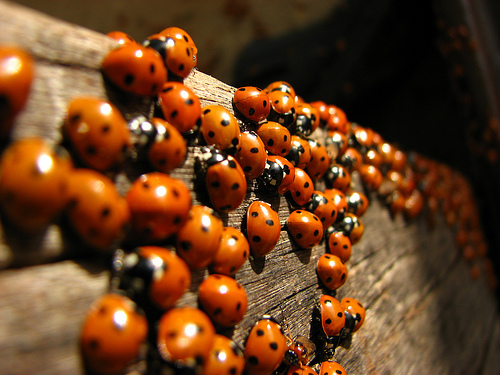The parasitic warfare perpetrated by ladybirds

There is a scientific term that causes fear and alarm to those that study biodiversity. More fear and alarm than the term climate change. Biotic homogenisation — introducing a new exotic species to an area that was, until now, without admixture. Worldwide there is an increase in introduced exotic species and the potential of these species to become invasive have their impact.
The most invasive ladybird on Earth — Harmonia axyridis — was introduced in several European countries and North America for biological pest control, and quickly turned invasive. It has been outcompeting indigenous ladybird species in many countries for a long time now. Ladybirds are quite common in use as a — what we now call — biological control agent. They have a long history of use against unwanted pest insects. For example, the Australian vedalia ladybird, Rodolia cardinalis, was released in 1888 to control scale insects.
Harmonia axyridis is also known as the harlequin ladybird, and it has been outcompeting and threatening native species since the beginning of the 20th century. Its invasive success has until now been attributed to its enduring resistance against diverse pathogens. The same pathogens that strike down and blight the native European species, allowing the harlequin ladybird to outperform and out-survive.
But now, Andreas Vilcinskas knows of another reason — and it is something more like parasitic warfare than simple evolutionary survival of the fittest.
Andreas Vilcinskas goes to work every day to kill ladybirds. Or rather, he goes to work to investigate how ladybirds kill each other. And it is the parasites within that act as the smart bomb against the native species. Harmonia have within them, swimming around in their blood, spores of the parasite microsporidia. They do no harm to Harmonia, but are lethal to the native ladybird Coccinella septempunctata. What is more interesting is that this lethality comes when the native species feed on microsporidia-infested Harmonia eggs or larvae. As is convention, ladybirds often eat the eggs of other ladybirds.
The tale of an invasive species is always something more akin to Kal-El leaving Krypton. You land in a foreign land with the realisation that you have superpowers (in comparison to the natives). The harlequin ladybird’s secret most likely lies within its blood (hemolymph). A hemolymph already shown to ward of mycobacterium and the parasite that causes malaria. Its blood, or more accurately, the metabolite harmonine within its blood, exhibits broad-spectrum antimicrobial activity. Antibacterial activity against Mycobacterium tuberculosis, and chloroquine-resistant Plasmodium falciparum strains.
For this new reason to awe the ladybird, Andrea Vilcinskas and colleagues drew blood from the legs of 100 ladybirds. With such super blood already documented, the question being: was the harlequin ladybird’s advantage over the native species simply down to harmonine, or did the microsporidia have a significant lethal effect.
They showed that injecting the native species with Harmonia blood — but not harmonine alone — can kill. Suggesting, that it is unlikely that the mortality caused by native species feeding on Harmonia eggs is caused by the presence of harmonine.
It seems that native ladybird species are lethally infected with microsporidia carried by Harmonia when they feed on its eggs and larvae. The microsporidia parasitize cells by means of a spear through the plasma membrane. Within two weeks of starting their experiment all native species had died from the microsporidia.
The most invasive ladybird on Earth lives up to its name. The worldwide invasion of the harlequin ladybird is as a result of a parasite that lies within. A parasite to which it has grown immune but to which the natives have no way of stopping. War of the Worlds gone backwards.
Image — source.
 Follow
Follow
Wow. Pretty and deadly!